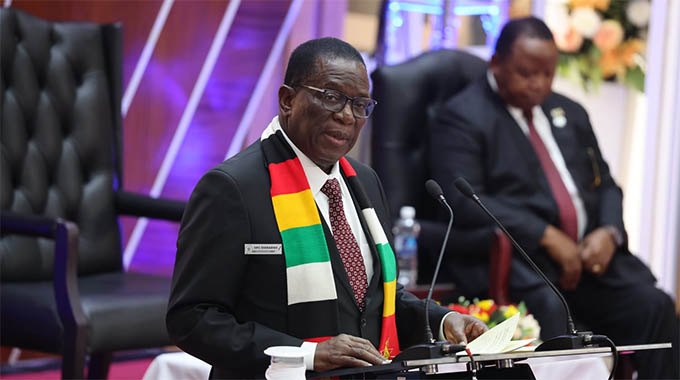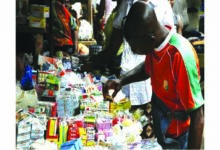PRESIDENT EMMERSON MNANGAGWA,7th SADC SUMMIT PUBLIC LECTURE

IN A POWERFUL ADDRESS DELIVERED TODAY AT THE UNIVERSITY OF ZIMBABWE, PRESIDENT EMMERSON MNANGAGWA OUTLINED A COMPELLING VISION FOR THE FUTURE OF THE SOUTHERN AFRICAN DEVELOPMENT COMMUNITY (SADC). HIS LECTURE, TITLED “BUILDING RESEARCH CAPACITY AND INNOVATION ECOSYSTEMS FOR A SUSTAINABLE INDUSTRIALISED SADC ECONOMY,” FOCUSED ON THE CRITICAL NEED FOR FOSTERING A CULTURE OF RESEARCH, INNOVATION, AND COLLABORATION WITHIN THE REGION TO DRIVE SUSTAINABLE ECONOMIC GROWTH.
. 1 Director of Ceremonies Our Host, the Vice Chancellor of the University of Zimbabwe, Professor P. Mapfumo; Honourable Vice President, Gen. (Rtd) Dr. C.D.G.N. Chiwenga; Honourable Vice President, Col. (Rtd) K.C.D.. Mohadi; Minister of Defence and ZANU PF National Chairperson, Hon. Cde O.C.Z. Muchinguri- Kashiri; Minister of Foreign Affairs and International Trade, Chairperson of the SADC Council of Ministers, Ambassador F.M. Shava; Ministers here present; Your Excellency, Mr. Elias Mpedi Magosi, SADC Executive Secretary; Your Excellency, Executive Secretary of the United Nations Economic Commission for Africa, Ambassador Claver Gatete; Your Excellencies, Members of the Diplomatic Corps; 2 Chief Secretary to the President and Cabinet, Dr. M. Rushwaya; Esteemed Guests from SADC and Beyond; Ladies and Gentlemen, Allow me, at the onset, to welcome you all to the Republic of Zimbabwe for the 7th SADC Summit Public Lecture.
This event is one of the precursors to the 44th Ordinary Summit of SADC Heads of State and Government to be held here in Harare, in the next two days. It affords the peoples of SADC the opportunity to reflect and sharpen strategies to accelerate our collective vision towards deepening regional integration as well as economic development for shared prosperity . The theme of this Lecture; “Building Research Capacity and Innovation Ecosystems for a Sustainable Industrialised SADC Economy”, is an apt call to action and encapsulates the need for new paradigms of education to leap frog the modernisation, industrialisation and wholistic development of SADC, 3 anchored on Research, Science, Technology and Innovation. In the case of Zimbabwe, this urgent imperative reality saw us successfully implement our Heritage-Based Education 5.0 philosophy. This discussion is being held against the backdrop where the SADC region has not been spared from the vagaries of climate change induced weather calamities, manifesting as droughts and cyclones. Additionally, other global shocks such as pandemics, geo-political conflicts and shifts in world trade patterns, all have far reaching consequences to the approaches that must be adopted by developing countries for a sustainable future. Combined, these factors, among others, signal the emergence of a new economic world order.
Our SADC Bloc has to position itself strategically to convert the realities of both domestic and global events into economic and business opportunities that lift our people into greater prosperity. 4 We have a duty to boldly and proactively address enclaves of disproportionate socio-economic development. The region should never play second fiddle in the arena of international economic relations. Leveraging on our combined resource endowments and human capacities the region must emerge as a competitive economic Bloc with the requisite capabilities to produce a wide array of goods and services. As SADC member states, we have all it takes to succeed. Esteemed Guests; In our quest to address the critical questions before us, it is critically important that we remain confident in our identity and capabilities. We are Africans and proud Southern African peoples, with a rich history of development and exploits, including conquering the oppressive, racist colonial regimes from our territories. 5 In Zimbabwe we say, “A country is built, governed and prayed for, by its people/ Nyika inovakwa, inotongwa, inonamatigwa nevene vayo/Ilizwe lakhiwa, libuswe, likhulekelwe ngabanikazi balo”.
This underscores the weighty responsibility we all carry to drive development in our countries from both an individual and collective standpoint. Gone are the days where we depended on people from elsewhere to develop our economies, provide services for our communities and avail goods for our industries and commerce.
The forebears and Founding Fathers of SADC fought for the political liberation, democracy, independence and freedom we are presently enjoying. This current generation of SADC citizens should take deliberate steps to exit perpetual dependency. It is at such forum that we should identify the goods being currently imported into the region so that our talented innovators and vibrant institutions can lead in import substitution. 6 Through appropriate and timely research as well as relevant science, technology and innovation, new business and trade opportunities should be created for SADC to become a key player in the world of today and that of the future. Further, information relating to trade opportunities brought about by our emerging trading bloc, the African Continental Free Trade Area (AfCFTA) along with possible synergies with other Regional Economic Communities, should be made less opaque for the generality of our people. This is essential if we are to expand markets, and open new routes into the broader global economy.
African Institutions such as Afrexim Bank and the African Development Bank, together with our respective financing and trade facilitation entities are challenged to scale up support and avail trade information for our people, especially youth and women-led industries. 7 To harness the new opportunities, SADC member states must sharpen capabilities around identified areas of comparative advantages. We should create business and trading niches which are unique and yet complimentary, to the countries of our region. For example, the next industrial revolution will be powered by renewable energy, primarily driven by lithium and solar energy.
As such, more research and skills must be developed to enable the establishment of a new generation of companies and industries around these sub-sectors to produce new forms of value added goods and products. For all the above to happen along with the accelerated modernisation and industrialisation, the right development philosophy is fundamentally important. This, in my view, lies in transforming our education and research ecosystem to be anchored on Science, Technology and Innovation. 8 As the people of SADC, we are urged to imagine and re-imagine the future we all want. We must be clear of where we want to go.
What our people want? What home grown technologies we need to industrialise? What should an industrialised SADC look like, in terms of its characteristics; the goods and services to be produced and the quality of life and prosperity to be realised. These are the questions that should form the basis for challenging our academia, scientists, innovators and inventors together with skills training institutions. Accordingly, industrialists, business sectors, development practitioners as well as communities in general, must play their part to transform systems and models that are fit for the shared regional aspirations. 9 The proposals and recommendations from the recently held SADC Industrialisation Week were insightful with regards to the trajectory to move our industrialisation agenda forward.
However, as long as the education system in our region remains skewed towards the past colonial architecture, it cannot adequately leap-frog the industrialisation of SADC. We must therefore transform the educational space to produce innovators and industrialists equipped with skills and competencies that develop products to meet the needs of our people. In Zimbabwe, our Heritage-based Education 5.0 Philosophy embraces research, innovation and industrialisation as important mandates for all levels of the education sector. This focuses on our God given natural and cultural endowments to drive development.
The appropriate research and innovation are fundamental to the advancement of both our domestic and regional development agenda. 10 With the correct configuration of our education, innovation, science and technology ecosystems, we can unlock maximum value from our natural resources and human capacities. The change of the education framework has seen my Government setting aside a specific budget for innovation, research and development.
In addition, policies have been crafted to ring-fence and provide funds to support the emerging innovation ecosystems. This has resulted in the establishment of Innovation Hubs, Industrial Parks, Science Parks and Incubation Centres across all institutions of higher education. Through the new education framework, our young people in the universities and colleges have exhibited immense capabilities, zeal and determination towards building a modern and industrialised Zimbabwe. 11 In the last five years, we have increased the number of Teacher Training Colleges that produce science teachers to ensure that all schools, in particular, those in the remote areas, offer science and ICT based learning. No place and no child is being left behind. This has ultimately broadened the pool of students transitioning to Colleges and Universities, following the science and technology pathways. In this way, we are building the critical mass of scientists and technologists to deliver an Innovation led and knowledge-based economy.
Further, our heritage-based education diversified innovation ecosystems by strengthening linkages between the academia, industry and commerce. This transformative education system has started to bear fruit. We have seen the emergence of various innovations and patents as new forms of assets.
12 Meanwhile, new technologies and start-up companies are producing relevant goods and services in response to the dynamic needs of industry, commerce and society. Notable entities that have emerged include Start-up companies in the local production of quality Vehicle Number Plates; science-based livestock production system for growing the national herd; a National Pathology Research and Diagnostic Centre for providing health diagnostic services; wine and juice producing plants from our local indigenous fruits; as well as another in the production of medical oxygen and industrial gases. All these have capacity to produce for the regional market and beyond.
This is a Zimbabwean model for industrialisation anchored on the philosophy “Nyika inovakwa, inotongwa, inonamatigwa nevene vayo/Ilizwe lakhiwa, libuswe, likhulekelwe ngabanikazi balo”. 13 Zimbabwe is ready to share experiences of this journey with SADC member states as we evaluate, review and restructure our respective education model to drive the industrialisation and modernisation of our Bloc. Distinguished Guests; SADC has unique opportunities that position us for success. We have all the requirements to become an economic powerhouse on the global arena. We are endowed with a rich resource-base, resilient and interconnected people; vast arable land for agriculture; a wide array of minerals, a good climate, abundant wildlife as well as a rich culture.
Our task is to unlock value from these diverse resources that we collectively share as a Bloc. Finally, let me reiterate the important need for SADC, to re-purpose our human capital resource pool and optimise production and productivity specialisation anchored on the right education philosophy and configuration. 14 To achieve this, the programming of our new education systems should be aligned to the abundant and key resources distributed across the SADC Bloc. I, therefore, challenge member states to further reflect on these critical issues as we re-organise and mobilise to drive forward our modernisation and industrialisation agenda, through the requisite knowledge, research, innovation and new technologies. No one and no member state must be left behind. The future of SADC is in our hands. Siyabonga, Tinotenda, Asante Sana, Merci, Obrigado, Thank you.


